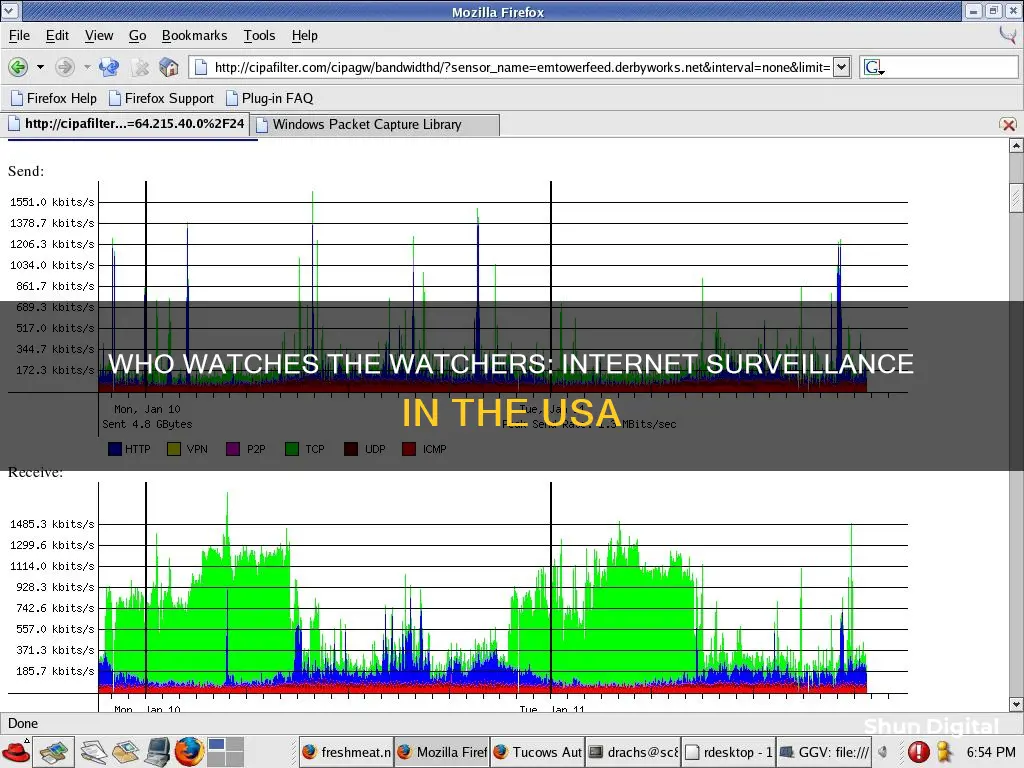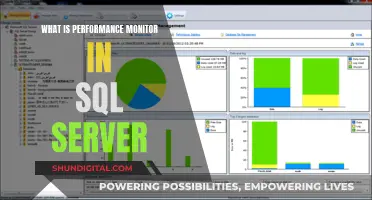
The internet has become an integral part of daily life in the USA, with 95% of US adults using it. As such, internet usage is monitored by various entities for different reasons. Internet Service Providers (ISPs) monitor usage to ensure a stable connection and can sell user data to corporations or governments. Governments monitor usage to maintain social control, identify threats, and prevent and investigate criminal activities. Civil rights and privacy groups have expressed concern over the potential for mass surveillance and the consequent limitations on personal freedom. To protect privacy, individuals can use tools such as VPNs, secure browsers, and privacy-focused search engines.
| Characteristics | Values |
|---|---|
| Percentage of U.S. adults who use the internet | 95% |
| Number of internet users in the U.S. | Over 311 million |
| Percentage of internet users who use search engines | 97% |
| Most used website | Google.com |
| Percentage of bank account holders who used online banking services on a PC or laptop | 44% |
| Number of mobile internet users in the U.S. | Over 295 million |
| Percentage of web traffic originating from mobile devices | Over 45% |
| Most popular mobile app | YouTube |
| Percentage of U.S. adults with high-speed broadband service at home | 80% |
| Percentage of U.S. adults who are "smartphone-only" internet users | 15% |
What You'll Learn

Government monitoring of internet usage
The monitoring of internet usage by the government is a growing concern for civil rights and liberties in the USA. The internet has become a fundamental part of daily life for Americans, with 95% of US adults using the internet. This shift has given the government an unprecedented ability to monitor the activities of its citizens.
Who is Monitoring Internet Usage?
The US government has several agencies that monitor internet usage, including the Department of Homeland Security, the FBI, the State Department, the Drug Enforcement Administration, the Bureau of Alcohol, Tobacco, Firearms and Explosives, the US Postal Service, the Internal Revenue Service, the US Marshals Service, and the Social Security Administration.
The government's monitoring of internet usage is often justified as a means to:
- Maintain social control
- Recognize and monitor threats or suspicious activity
- Prevent and investigate criminal activities
- Conduct immigration and travel screening
- Gather information for investigations
The government monitors a wide range of online activity, including:
- Social media activity
- Phone calls and broadband internet traffic (emails, web traffic, instant messaging, etc.)
- Online banking services
- Search engine usage
- Mobile internet usage
- Social media messages, likes, and comments
There are several concerns regarding the government's monitoring of internet usage, including:
- Civil rights and liberties: The monitoring of internet usage raises concerns about freedom of speech, assembly, and religion, especially for historically targeted communities such as Black, Latino, and Muslim communities.
- Privacy: The government's collection of personal information, such as political views, religious practices, and health information, poses a risk to individuals' privacy.
- Accuracy: Misinterpreting online activity can have severe consequences, such as false arrests or travel restrictions.
- Chilling effects: Individuals may self-censor or refrain from expressing themselves online due to the knowledge that they are being monitored.
- Effectiveness: There is little evidence that monitoring internet usage effectively advances security objectives, and it may instead crowd out resources from more effective public safety measures.
- Corporate surveillance: The government often gains access to personal data collected by corporations, which raises concerns about the role of private companies in government surveillance.
Best Routers for Bandwidth Monitoring and Control
You may want to see also

ISP monitoring of internet usage
Internet Service Providers (ISPs) are monitoring your online activity, and they can sell your data to corporations and governments. The extent of their authorization to do so is decided by local law, regulations, and policies. Here are some of the ways in which ISPs monitor your internet activity:
- IP addresses are assigned to devices by the provider, to track the source and destination of data packets.
- Log patterns: when you connect and disconnect from the service.
- URLs and time spent on each particular site.
- Data amount — transmitted and received.
- Metadata.
ISPs monitor internet usage for several reasons:
- Data usage monitoring: ISPs track internet usage to monitor data consumption, especially in regions with data caps or usage-based plans.
- Network management: Tracking internet usage helps ISPs manage network traffic and ensure optimal performance for all users, including addressing congestion issues.
- Compliance with regulations: ISPs may track internet usage to comply with legal requirements, such as enforcing copyright laws or monitoring for illegal activities.
- Customized services: Tracking user behaviour allows ISPs to offer personalized services, such as targeted advertising or tailored internet plans.
- Security and law enforcement: ISPs may track internet usage to identify and address security threats and cooperate with law enforcement agencies.
ISPs typically track data through deep packet inspection (DPI) or by logging domain name system (DNS) requests. DPI involves analyzing the contents of data packets transmitted over the network, while DNS logging involves recording the information that users request translations for.
While ISPs can monitor your internet activity, there are ways to protect your privacy. Using a Virtual Private Network (VPN) can help conceal your internet activity from your ISP by creating an encrypted connection between your device and a remote server. Additionally, using privacy-focused web browsers and search engines can also help protect your data from being harvested by third parties.
Monitoring Water Usage: Baltimore County's Conservation Efforts
You may want to see also

Data-retention laws
Understanding Data-Retention Laws
- Storage and disposal protocols
- Data formatting guidelines
- Systems and devices used for storing data
- Length of the data retention period
Data Retention in the United States
The United States does not have a comprehensive data retention law, but various government agencies have implemented rules for specific businesses and industries. Here are some key data retention requirements by industry:
- Sarbanes-Oxley Act: Organizations must retain select auditing documents for seven years after the audit's completion.
- Gramm-Leach-Bliley Act: Financial institutions must dispose of customer data no later than two years after its last use.
- Fair Labor Standards Act: Employers must retain employee records, personal information, payroll data, and hours worked for at least three years.
- Payment Card Industry Data Security Standard: Businesses accepting credit card payments must comply with annual audits and create their own specific policies.
- Health Insurance Portability and Accountability Act (HIPAA): Businesses dealing with electronic health information must retain all electronic health records for at least six years.
Best Practices for Data Retention Policies
When creating or updating data retention policies, organizations should consider the following best practices:
- Start with Data Discovery and Classification: Identify and classify all data, including employee documentation, billing information, transaction records, and medical documentation.
- Engage Stakeholders: Gain support from executives and senior stakeholders by clearly articulating the policy's value and providing deadlines.
- Document Lifecycle Management: Comply with regulatory mandates by documenting data creation, storage, usage, archival, and disposal.
- Only Retain Necessary Data: Minimize the risk of cyber attacks and optimize storage space by retaining only the data required for compliance and operational purposes.
- Keep the Policy Simple and Understandable: Use plain language in the internal version of the policy to ensure stakeholders and employees comprehend and adhere to the guidelines.
- Back Up Data Consistently: Implement a backup retention schedule that aligns with your organization's needs and complies with regulations to prevent data loss in disasters.
- Invest in an Archiving Solution: Use cloud-based repositories to securely store inactive data, enhance system performance, and improve data organization and retrieval.
Monitoring Firestick Usage: A Step-by-Step Guide for Parents
You may want to see also

Social media monitoring
There are numerous social media monitoring tools available that offer varying levels of sophistication. These tools can be used by businesses of all sizes and can provide real-time insights, allowing teams to analyze trends and respond appropriately.
- Sprinklr: Offers advanced listening and monitoring capabilities, providing real-time insights and cross-channel insights.
- Hootsuite: Includes features for content creation, scheduling, analytics, and social listening. Hootsuite Listening is included in every plan and offers Quick Search to discover trending hashtags, brands, and events.
- Talkwalker: Monitors conversations across 150 million data sources, including blogs, forums, videos, news sites, review sites, and social networks.
- Agorapulse: Enables brands to create actionable searches to monitor mentions across social networks, news websites, and blogs.
- Mentionlytics: A multilingual tool that tracks mentions, keywords, and sentiment in multiple languages.
- Reputology: Allows users to monitor major review sites such as Yelp, Google, and Facebook reviews.
- Fedica: Helps businesses identify and engage with accounts aligned with their target demographics.
- Reddit by Synaptive: Monitors conversations on Reddit for specific keywords, providing insights into public sentiment and upcoming trends.
- Digimind: Expands social media monitoring to 850 million sources and incorporates AI for trend and sentiment analysis.
- Sprout Social: Helps track conversations, understand audience demographics, and identify influencers.
- Mention: Tracks over a billion data sources and includes sentiment analysis and visual reporting.
- Keyhole: Provides real-time data and insights on social media conversations, with a focus on X (formerly Twitter), Instagram, and Facebook.
- Emplifi (formerly Socialbakers): Covers day-to-day media monitoring, interaction, media listening, content research, planning, and influencer discovery.
- Meltwater: A comprehensive suite of tools for social media monitoring, including audience insights, sentiment analysis, and influencer management.
- Cyfe: Centralizes insights from media activity and other data into widget-filled dashboards.
- Talkwalker: An advanced monitoring and insights tool for large agencies and global brands, offering consumer sentiment insights, competitor benchmarking, and reputation management.
- Statusbrew: Provides omnichannel monitoring through a Unified Inbox, simplifying social interactions across various networks.
- Digimind: A tool focused on brand reputation monitoring, gathering insights on reader sentiment from main networks and publications.
- Brand24: Offers day-to-day social media monitoring, with keyword searches and sentiment analysis across core channels, blogs, news sites, and visual platforms.
- Agorapulse: A management platform with social media monitoring functionality, including a Social Inbox for easy response to brand mentions and conversations.
- Synthesio: Provides multiple interactive dashboards for audience monitoring, advanced data reporting, and key business insights extraction.
- TweetDeck: X's social media monitoring dashboard, allowing users to track and respond to X mentions and conversations.
- Awario: A flexible tool that scales with a business's growth, tracking mentions, competitors, influencer interactions, and brand perception.
- Buffer: Offers a publishing platform and social monitoring and analytics capabilities, providing insights on comments, mentions, retweets, likes, and shares.
By utilizing these social media monitoring tools, businesses can gain valuable insights into their brand reputation, audience sentiment, competitor activities, and industry trends. This information can be used to enhance marketing strategies, improve customer engagement, and make data-driven decisions.
Monitoring Data Usage: Apps to Track and Control
You may want to see also

Surveillance technologies
Surveillance is the monitoring of behaviour, activities, or information for the purpose of gathering information, influencing, managing, or directing. Surveillance technologies are the tools and methods used to carry out this monitoring. These technologies can be used by governments, corporations, criminal organizations, and even individuals for various purposes, such as intelligence gathering, crime prevention, or simply satisfying curiosity.
- Closed-circuit television (CCTV): Video cameras that are often connected to a recording device or IP network and may be monitored by security personnel or law enforcement. These cameras are now simple and inexpensive enough to be used in home security systems.
- Internet Protocol (IP) Address Tracking: This allows surveillance entities to identify the approximate geographic location of a device and track online activities.
- Deep Packet Inspection (DPI): This technology accesses the data within network packets, allowing surveillance entities to monitor online activities, enforce bandwidth limits, or block access to specific websites.
- Browser Fingerprinting: A technique that collects information about a user's web browser (version, plugins, etc.) to create a unique fingerprint, making it possible to identify a person even when using a VPN or clearing cookies.
- Metadata Collection and Analysis: Metadata is the unencrypted data description of electronic communications, including time, date, and communication participants. It can be used to identify behavioural patterns, interests, or relationships.
- Social Media Monitoring: Surveillance entities monitor public posts, profiles, and trends on social media platforms. They may also use undercover agents with fake profiles to interact with targets.
- Use of Malware and Spyware: Malicious software is used to record sensitive information, such as video, audio, keystrokes, or files.
- Biometric Surveillance: This technology measures and analyzes human physical and behavioural characteristics, such as fingerprints, DNA, facial patterns, gait, or voice. For example, facial recognition technology is used to identify individuals in surveillance video footage.
- Geolocation Tracking: Surveillance entities can determine the geographical location of a mobile phone, and thus, the person carrying it, using multilateration techniques that calculate the time it takes for a signal to travel from the phone to nearby cell towers.
- StingRay Tracker: A tool used to monitor cell phone usage by broadcasting powerful signals that cause nearby phones to transmit their IMSI number. Once connected, the operator can extract information such as location, phone calls, and text messages.
- Virtual Private Networks (VPNs): While VPNs are often used to protect privacy, they can also be used as a surveillance tool. By creating a tunnel between a device and a server, VPNs can conceal and limit the information that an Internet service provider (ISP) can see. However, the use of VPNs may also be monitored and tracked by surveillance entities.
- Employee Monitoring: Employers may monitor their employees' online activities, including websites visited, time spent on each site, and data transmitted and received. This can be done directly by the employer or through third-party tools and apps.
Monitoring Data Usage: Your Nighthawk Router Guide
You may want to see also
Frequently asked questions
Internet Service Providers (ISPs) monitor internet usage in the USA, and they are often influenced by government agencies. ISPs can monitor IP addresses, log patterns, URLs, time spent on sites, and data amounts.
ISPs use various methods to monitor internet usage, including IP address tracking, deep packet inspection, browser fingerprinting, and metadata collection and analysis.
ISPs collect information such as IP addresses, log patterns, URLs visited, time spent on each site, and data amounts transmitted and received. This data is often shared with government agencies through legal requests or intelligence-gathering efforts.







